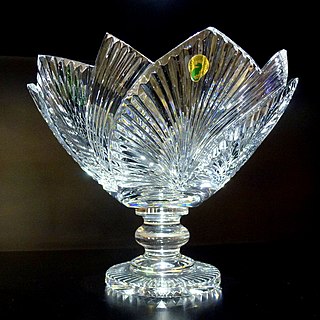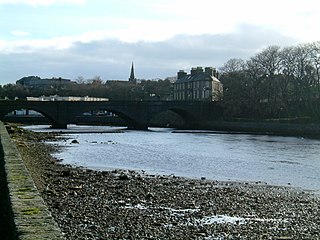Related Research Articles

John Archibald Sinclair, 3rd Viscount Thurso, known also as John Thurso, is a Scottish businessman, Liberal Democrat politician and hereditary peer who is notable for having served in the House of Lords both before and after a period in the House of Commons.

Crieff is a Scottish market town in Perth and Kinross on the A85 road between Perth and Crianlarich, and the A822 between Greenloaning and Aberfeldy. The A822 joins the A823 to Dunfermline. Crieff has become a hub for tourism, famous for whisky and its history of cattle droving. Attractions include the Caithness Glass Visitor Centre and Glenturret Distillery. The nearby Innerpeffray Library is Scotland's oldest lending library. St Mary's Chapel beside it dates from 1508. Both are open to the public: the library is run by a charitable trust; the chapel is in the care of Historic Scotland.

Thurso is a town and former burgh on the north coast of the Highland council area of Scotland. Situated in the historical County of Caithness, it is the northernmost town on the island of Great Britain. From a latitudinal standpoint, Thurso is located further north than the southernmost point of Norway and in addition lies more than 500 miles (800 km) north of London.

Caithness is a historic county, registration county and lieutenancy area of Scotland.

Waterford Crystal is a manufacturer of lead glass or "crystal", especially in cut glass, named after the city of Waterford, Ireland. In January 2009, the main Waterford Crystal manufacturing base on the edge of Waterford was closed due to the insolvency of Waterford Wedgwood PLC, and in June 2010, Waterford Crystal relocated almost back to the roots of glass-making in the city centre. The Mall location holds both a manufacturing facility that melts over 750 tonnes of crystal a year – although most Waterford Crystal is now produced outside Ireland – and a visitor centre with the world's largest collection of Waterford Crystal. As of 2015, the brand is owned by the Fiskars Corporation.

Wick Academy Football Club are a senior football club founded in October 1893, who currently play in the Scottish Highland Football League at Harmsworth Park. They represent the Caithness town of Wick, making them the most northerly professional football league club in the United Kingdom.

Dartington Crystal is a British manufacturer of crystal glassware and it's based in the town of Torrington in North Devon, England. The company manufactures their glassware using traditional glass blowing techniques.

Wheaton Industries was a manufacturer of glassware and ceramics products in Millville, New Jersey, USA. A spin-off of the original firm adopted the name in 2006.

Wick is a town and royal burgh in Caithness, in the far north of Scotland. The town straddles the River Wick and extends along both sides of Wick Bay. "Wick Locality" had a population of 6,954 at the time of the 2011 census, a decrease of 3.8% from 2001.

Baccarat is a French luxury house and manufacturer of fine crystal located in Baccarat, Meurthe-et-Moselle, France. The company owns two museums: the Musée Baccarat in Baccarat, and the Musée Baccarat in Paris on the Place des États-Unis.

Georgemas Junction railway station is a railway station located in the Highland council area in the far north of Scotland. It serves several rural hamlets in the historic county of Caithness, including Georgemas, Roadside and Banniskirk. It is also the nearest station to the village of Halkirk, which lies approximately 1.6 miles (2.6 km) west of the station.

Wick railway station is a railway station located in Wick, in the Highland council area in the far north of Scotland. It serves the town of Wick and other surrounding areas in the historic county of Caithness, including Staxigoe, Papigoe and Haster. The station is the terminus of the Far North Line, 161 miles 36 chains from Inverness. It is managed by ScotRail, who operate all trains serving the station.

Edinburgh Crystal was a cut glass manufactured in Scotland from c. 1820s to 2006, and was also the name of the manufacturing company. In addition to drinking glasses, Edinburgh Crystal made decanters, bowls, baskets, and bells, in several ranges.
Cambridge Glass was a manufacturer of glassware formed in 1873 in Cambridge, Ohio. The company produced a range of coloured glassware in the 1920s, initially with opaque shades, but moving on to transparent shades by the end of the decade. Unable to compete with mass-produced glassware, the company closed briefly in 1954, but was reopened in 1955. However, financial difficulties persisted, and, after several ownership changes, the factory closed for good in 1958. Imperial Glass Company purchased the Cambridge Glass molds two years later, and would use them for another three decades until that company went bankrupt in 1984.
The Lochearnhead, St Fillans and Comrie Railway company was formed to build a line along the valley of Strathearn, closing the gap between the Callander and Oban line of the Caledonian Railway and Crieff. Tourism was on the increase in the area, and there were ambitious ideas that imported goods traffic at Oban would be routed to the eastern Scotland towns and cities over the line.
The Crieff and Methven Junction Railway was a Scottish railway, opened in 1866, connecting Crieff with a branch line that ran from Methven to Perth.
The Sutherland and Caithness Railway was a Scottish railway company that built a line from Helmsdale, the terminus of the Duke of Sutherland's Railway to Wick and Thurso in Caithness, giving the northern towns access to Inverness. It was driven through by the efforts of the 3rd Duke of Sutherland and the engineer Joseph Mitchell in the face of apathy from interests in Wick.
The firm of James Powell and Sons, also known as Whitefriars Glass, were London-based English glassmakers, leadlighters and stained-glass window manufacturers. As Whitefriars Glass, the company existed from the 17th century, but became well known as a result of the 19th-century Gothic Revival and the demand for stained glass windows.
The Far North Line was built in several stages through sparsely populated and undulating terrain within the Highland area of Scotland. Extending to 161 miles (259 km), it runs north from Inverness to Wick and Thurso in Caithness, and currently carries a regular passenger train service.
References
- ↑ "OBITUARY: Viscount Thurso". 1 May 1995. Retrieved 13 August 2016.
- ↑ Nichols, Anne. "Caithness Glass Co Ltd" . Retrieved 13 August 2016.
- ↑ "Caithness History - Caithness Glass Paperweights". Archived from the original on 28 August 2016. Retrieved 13 August 2016.
- ↑ "Caithness Glass" . Retrieved 13 August 2016.